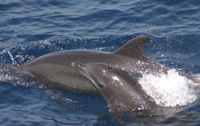2008 Indian River Lagoon Bottlenose Dolphin Unusual Mortality Event
 Bottlenose Dolphins (Tursiops truncatus) Photo: NMFS Southwest Fisheries Science Center |
An increased number of bottlenose dolphins (Tursiops truncatus) mortalities were reported in the Indian River Lagoon (IRL), Florida, from May 3, 2008, to the present. Since May, 44 dolphin mortalities spanning all age classes have been reported. The majority of the animals have been in a moderate state of decomposition, emaciated with empty stomachs and are distributed in a larger area of the northern IRL.
On July 21, 2008, a consultation was initiated with the Working Group following the procedures prescribed in 16 U.S.C. 1421c, section 404 of the Marine Mammal Protection Act (MMPA) to determine if an unusual mortality event was in progress and to solicit guidance on the investigation. The Working Group concluded at least two of the seven criteria established for designation of a UME had been met. These mortalities are unusual because:
- there is a marked increase in the magnitude or a marked change in the nature of morbidity, mortality or strandings when compared with prior records (criteria number one); and
- affected animals exhibit similar or unusual pathologic findings, behavior patterns, clinical signs, or general physical condition (e.g., blubber thickness) (criteria number five).
This event is the second mortality event of bottlenose dolphins in this area. Dolphins in the Indian River Lagoon have undergone one previous UME in June and July of 2001, in which 29 animals died. While a biotoxin, saxitoxin, was the suspected cause of the 2001 dolphin mortality event, it was difficult to confirm. Saxitoxin-producing Pyrodinium bahamense blooms have been problematic in the IRL since 2002, closely following the 2001 bottlenose dolphin die off. In addition, this population of dolphins has been the focus of a multi-year health assessment study from 2003 to 2007; therefore, significant pre-event data exist for comparisons with the current mortality.
The investigation into this event is ongoing. The Southeast Stranding Response team is collaborating with the Florida Fish and Wildlife Conservation Commission and National Estuary Program to obtain and analyze relevant harmful algal bloom data especially in light of the history of Pyridinium blooms in the area.